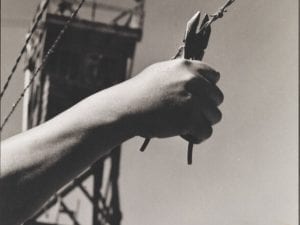A lot has changed since the start of the Industrial Revolution (1760-1840). In 1700, the world had a population of 670 million people. By 2011, it had reached 6.7 billion, a 10-fold increase in 300 years. Now, it’s at over 8 billion. Every aspect of human life has changed: travel has become faster, communications smoother, production quicker and conducted at scale. There have been myriad benefits for healthcare, education and employment. Yet their distribution has been far from equal. Moreover, rapid change has been detrimental to the planet: the acidity of surface ocean waters has increased, air temperatures have risen and the Earth’s surface has warmed. Great swathes of land have been destroyed to make way for industry. Mexican-British artist Mónica Alcázar-Duarte (b. 1977) is interested in western society’s obsession with speed, expansion and resource accumulation. At a time when ecological disaster looms, and misinformation is rife, she asks: where does knowledge truly lie? Who decides what happens next? And what does the idea of “progress” really mean? In Digital Clouds Don’t Carry Rain, a new exhibition at Autograph, London, Alcázar-Duarte looks to her ancestors’ Indigenous knowledge for answers, joining together threads of information that have persisted throughout time. We speak to the artist, who is a former Aesthetica Art Prize finalist, about the show and its complex historical underpinnings.
A: How would you describe “knowledge systems”, for those who are unfamiliar with the concept?
MAD: A knowledge system is not a given; it’s a human construct. It establishes a benchmark for moving forward as a species – in terms of self-understanding, growth, survival, and what constitutes “sophistication”. It establishes the way things are – or, at least, how they are supposed to be – and tells us “this is how things work.” I am interested in the idea of “universal” knowledge: what is included within it, by whom and how? Why is it that some types of knowledge are considered cultural curiosities, instead of accepted as different ways of understanding, experiencing and knowing? An example is the different validity given to written information, in comparison to that of inherited oral knowledge.

A: It’s a huge topic, but what is their role in the construction of identities, histories and power?
MAD: I am very interested in language and the power it holds in western science. It has deep roots in commerce and colonisation: the act of naming and classifying resources is a claim to ownership, and, in this way, science became the language of the future. The colonial project, enhanced by the Industrial Revolution, supplanted Indigenous stewardship by ideals of ownership, production, efficiency and resources. It was a project in which profit was more important than life. Any language which did not conform to the structure science presented was rendered obsolete, and therefore part of the past.
A: Your work is all about joining together threads of dissociated knowledge systems. What sparked that idea? Which knowledge banks do you seek to connect?
MAD: In Digital Clouds Don’t Carry Rain, I refer to the 1592 burning of Mayan codices by Spanish bishop Diego de Landa, who believed Mayan culture was evil and needed to be erased. I was shocked at the amount of Mayan history that is written or narrated by Spanish explorers. There are other instances in which the texts are written by Indigenous people, but usually under the supervision of Spanish explorers. After de Landa erased as much as he could, the remaining knowledge was translated and re-configured to fit within colonial power structures and narratives. What interests me, however, is that some traditional processes survived by making themselves relevant and palatable. These ideas continued to be transmitted through generations. Imagine the amount of resistance that is required for this to happen! An example of this is indigenous medicinal plants, that were used later to develop pharmaceuticals.

A: How have you approached that task? Your self-portraits are particularly poignant examples of this.
MAD: I started learning Maya. There are concepts in Maya that mean something completely different than they do in English and Spanish. There are other notions that simply do not exist in either language. These are the ideas that attract me the most; they recognise nature not as a resource, or a thing to be controlled and tamed, but as a living being that moves, breathes and is in constant change. It is a force of its own and we are only a small part of it. We are surrounded by it, not on top of it. My self-portraits are a way of manifesting my Mesoamerican heritage, specifically in relation to its understanding of time as non-linear. I layer different historical periods and knowledge systems in the same frame. I mimic poses from 18th century Casta paintings, a genre of art made in Mexico during Spanish colonialism to illustrate racist social hierarchies – classifying mixed race individuals within a ‘caste’ system.
A: Can you tell us about some of your symbolism, like copper, fleur-de-lis and masks?
MAD: Copper appears throughout the exhibition – embedded not only in my images but also in an installation comprising 56 metal flowers. This is a reference to the lineage of extraction in Mexico, which began whilst the country was being colonised. Today, it is the 7th largest producer in the world; its copper is used for global Internet cabling. The flowers on the masks, meanwhile, refer to blooms important to the Mayan stingless bee. These insects have been around for thousands of years, but they are barely surviving today due to deforestation in the Yucatán Peninsula. Somehow, however, they keep finding carers; the communities who keep them are deeply emotionally connected to them. Similarly, lilies recur in my work because they represent a system with an ability to transcend. As well as associations with nobility, the lily has an ignoble connection with slavery. It has managed to become palatable today, and is often used in connection with popular culture.

A: What is the significance of the show’s title: Digital Clouds Don’t Carry Rain?
MAD: The title relates to methods of extraction, and how they are connected to the ecological crisis. It also reflects the cyclical nature of historical systems of oppression, which have evolved into contemporary forms of exploitation. Digital Clouds Don’t Carry Rain exposes today’s techno-capitalist society, revealing where the idea that “growth is a sign of advancement” originally came from.
A: Your practice is interdisciplinary, combining photography and film with datasets, algorithms and augmented reality. How do you see the relationship between creativity and technology evolving? Is AI in the arts something to be feared, to embrace – or somewhere in-between?
MAD: AI, as a creative tool, can be used to show you how to have a different conversation, or to enhance the types of conversations you are already having. Up to now, whatever the results are, these are like ripples; variation-repetitions of a conversation you are having with yourself. AI is a tool, and humans are behind it. This tool reflects us. If, one day, we manage to emulate the human condition into these tools, we might finally have to accept that we are not as important as we once thought. The questions we should fear most are around how we will use AI, for what purposes, under which circumstances, and for whose benefit.

A: What’s next for you? Any new projects or exhibitions on the horizon?
MAD: There are three upcoming shows in 2024. One is in Houston, as part of the Foto Fest Biennial, where I am showing a multi-channel installation of a film supported by National Geographic. Then I’ll be in Germany as part of Celina Lundsford’s curation for RAY Triennial. Later, my work will travel to The Netherlands; it’s in a show curated by Ileana Selejan. I am working on three other projects that are at different stages of research, production and editing. One has been made possible through a residency supported by the Musée du quai Branly-Jacques Chirac, Paris.
Mónica Alcázar-Duarte: Digital Clouds Don’t Carry Rain is at Autograph, London, until 1 June.
All images © Mónica Alcázar-Duarte.
1. Mónica Alcázar-Duarte, Yum Kaax-Mayan Jungle deity, 2023. From the series Digital Clouds Don’t Carry Rain. Courtesy the artist.
2. Mónica Alcázar-Duarte, Ixchel-Mayan Moon and Birth deity, 2021. From the series Digital Clouds Don’t Carry Rain. Courtesy the artist.
3. Mónica Alcázar-Duarte, Itzamná-Mayan Time deity, 2021. From the series Digital Clouds Don’t Carry Rain. Courtesy the artist.
4. Mónica Alcázar-Duarte, Kukulkan-Mayan Serpent deity, 2023. From the series Digital Clouds Don’t Carry Rain. Courtesy the artist.
5. Mónica Alcázar-Duarte, K’aaxal ja’-Mayan Thunder deity, 2021. From the series Digital Clouds Don’t Carry Rain. Courtesy the artist.





